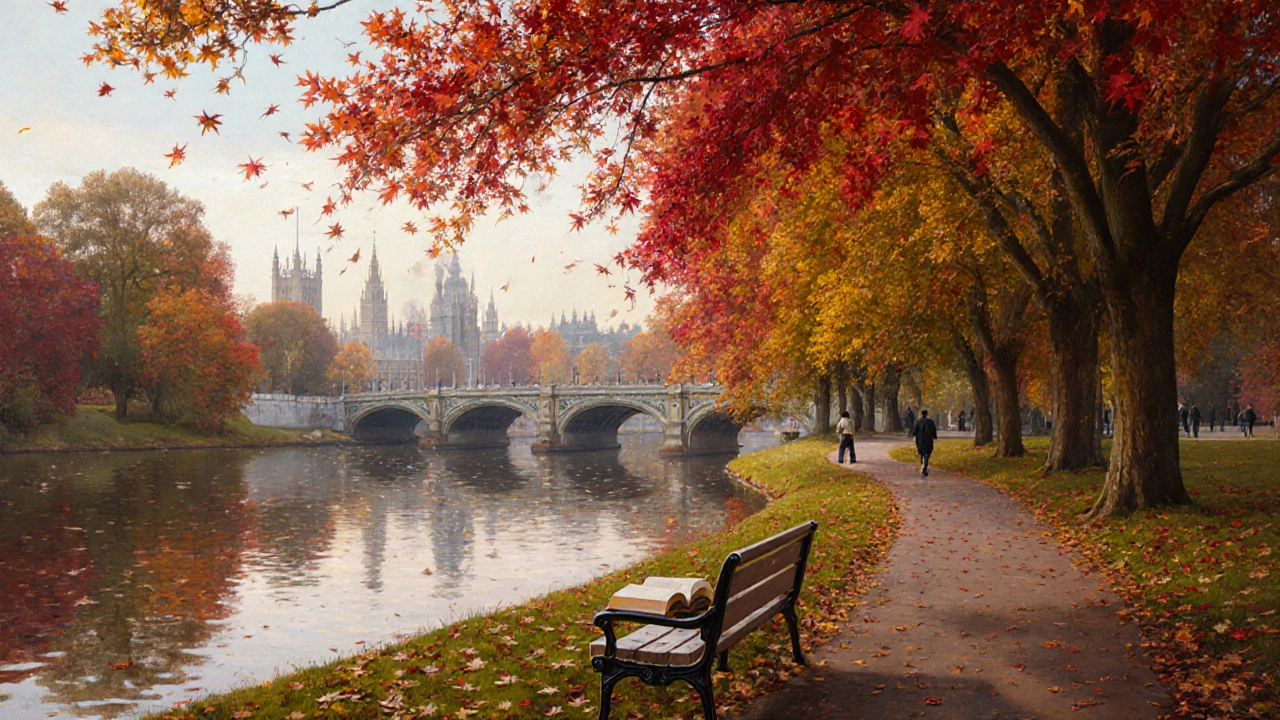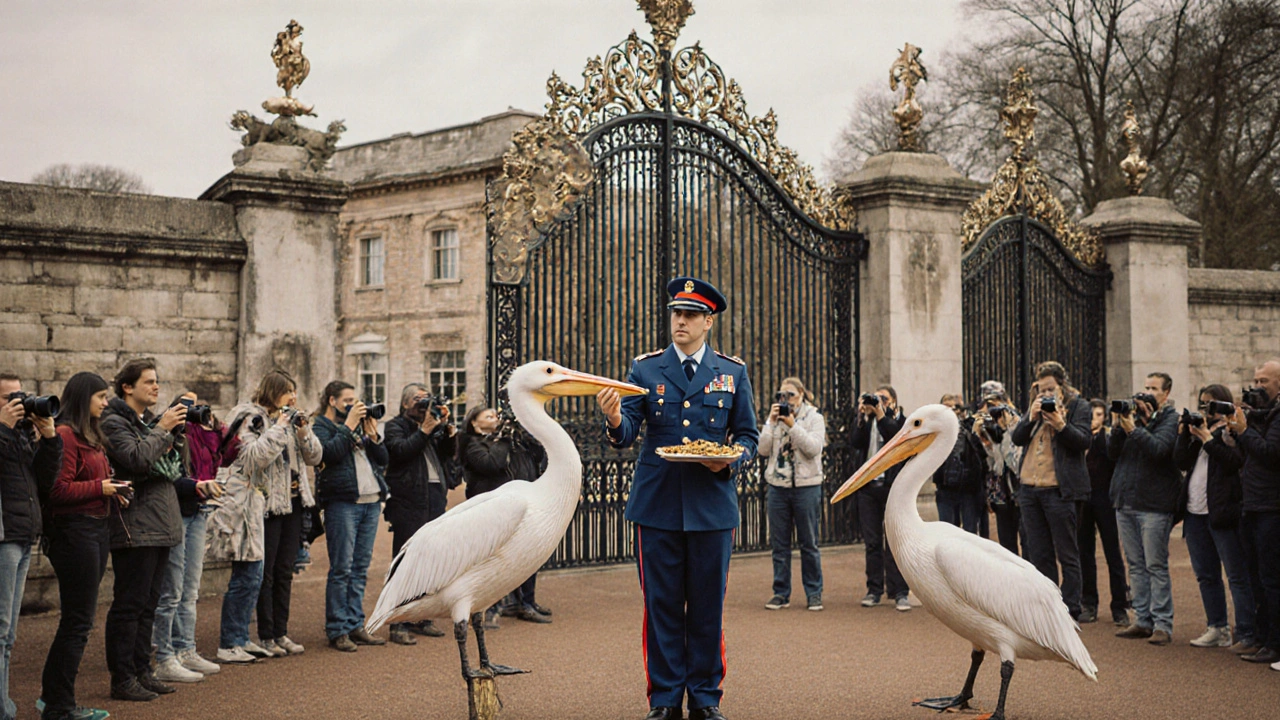
St James’s Park isn’t just another London park. It’s the oldest royal park in the city, sitting right in the heart of Westminster, with Buckingham Palace on one side and the Houses of Parliament on the other. You can walk here from Trafalgar Square in under 15 minutes, and yet, once you step through the gates, the city noise fades. Birdsong takes over. The water ripples. People sit on benches with coffee, kids chase ducks, and tourists pause to take photos of the pelicans being fed at 2:30 p.m. every day - a tradition that’s been going on since the 1660s.
History That Walks With You
St James’s Park started as a hunting ground for Henry VIII in the early 1500s. He turned a leper hospital into a deer park, and by the 1660s, Charles II had it redesigned in the French formal style after his exile in France. Think straight paths, symmetrical flower beds, and ornamental lakes. It wasn’t until the 1820s that John Nash, the architect behind Buckingham Palace, reshaped it into the more natural, English landscape we see today - rolling lawns, winding paths, and islands in the lake that feel like they’ve always been there.
Even the name comes from history. It’s named after the medieval Hospital of St James, which once stood here treating lepers. The hospital’s chapel became the private chapel for the royal family, and eventually, the whole area took on its name. You can still see the original boundary walls near the park’s south end - weathered stone blocks that have seen kings, queens, and tourists pass by for over 500 years.
The Ducks, the Pelicans, and the Wildlife
St James’s Park is one of the few places in central London where you can watch wild birds up close without feeling like you’re in a zoo. The park is home to over 80 species of birds, including mallards, coots, moorhens, and the famous pelicans. These pelicans aren’t just decorations - they’re part of a living tradition. Since the 17th century, pelicans have lived here, gifted to British monarchs by foreign dignitaries. Today, the pelicans are cared for by the Royal Parks staff, and every day at 2:30 p.m., they’re fed by a keeper in a blue uniform. Crowds gather, phones come out, and the pelicans waddle down the path like they own the place - because, in a way, they do.
There’s no need to bring bread. Feeding the ducks with anything but park-approved food can harm them. The park sells special duck food at kiosks near the lake. If you bring your own, stick to oats or chopped lettuce. No white bread. No crisps. No junk food. The ducks have been around longer than most of the cafes in Westminster - they deserve better.
Where to Sit, When to Visit
If you want peace, go early. On weekdays, the park is quiet before 9 a.m. Locals jog along the paths, dog walkers chat in hushed tones, and the only sounds are footsteps and distant church bells. By noon, it fills up with office workers on lunch breaks, tourists with maps, and couples posing for photos in front of the lake with the palace in the background.
The best spot to sit? The western bench near the bridge that leads to the Mall. It faces the palace, has no direct sunlight in the afternoon, and offers a clear view of the pelicans feeding. On weekends, the southeast corner near the Children’s Playground is lively with families. The north end, near the statue of Queen Victoria, is quieter and shaded by old plane trees - perfect for reading.
Spring and autumn are the best seasons. In April, the tulips bloom in the flower beds near the lake. In October, the maple trees turn bright red, and the water reflects them like stained glass. Summer can be crowded and hot, but the lake breeze helps. Winter is quiet, frosty, and magical - the park is empty enough that you can hear your own footsteps on the gravel paths.

What You’ll See Around the Park
St James’s Park doesn’t exist in isolation. It’s surrounded by landmarks that make it more than just a green space.
- Buckingham Palace - The Queen’s official London residence. Watch the Changing of the Guard at 11 a.m. daily (April-July) or 10 a.m. the rest of the year. The guard marches right through the park’s east gate.
- The Mall - The grand red-brick road that leads from the park to Trafalgar Square. Used for royal processions, including coronations and jubilees. Walk it on a quiet morning and imagine the crowds from the Platinum Jubilee in 2022.
- Whitehall - The street that runs along the park’s west side. Home to the UK government’s main offices, including the Prime Minister’s residence at 10 Downing Street, just a five-minute walk away.
- Westminster Abbey - The Gothic church where kings and queens are crowned. It’s less than a 10-minute walk from the park’s south end. Many visitors combine a walk through the park with a visit to the Abbey.
- The Horse Guards - The 18th-century building that once housed the royal cavalry. Now it’s the entrance to the Ministry of Defence. The building’s clock tower is a landmark, and the guards in red tunics and bearskin hats stand sentry outside.
There’s no need to rush. You can spend half a day here without seeing everything. The park connects to Green Park in the west and Hyde Park in the north. Walk the full route and you’ll cover nearly 3 miles of royal green space - all without stepping on a road.
Practical Tips for Visitors
- Open all year - The park is free and open from 5 a.m. to midnight daily. No tickets, no gates, no entry fee.
- Public transport - The nearest Tube stations are St James’s Park (District and Circle lines), Westminster (Jubilee, District, Circle), and Victoria (Victoria, District, Circle). All are under a 10-minute walk.
- Restrooms - Clean, free public toilets are near the main entrance on Birdcage Walk and by the lake near the pelican feeding area.
- Food and drink - There are two cafés: one near the main entrance and another by the lake. Prices are high, but the views are worth it. Bring your own picnic - there are plenty of grassy spots.
- Accessibility - All main paths are paved and wheelchair-friendly. Ramps lead to the lake bridges, and tactile paving helps visually impaired visitors navigate.

Why It Still Matters
St James’s Park isn’t just a pretty place. It’s a living piece of British history that’s still used every day. It’s where the royal family walks their dogs. Where Londoners go to think, grieve, or celebrate. Where tourists take their first real breath of London air. It’s not manicured to perfection - it’s lived-in. The grass gets worn down in spots where people sit every lunchtime. The benches have names scratched into them. The pelicans have personalities.
In a city of 9 million people, it’s one of the few places where time slows down. No ads. No billboards. No screens. Just trees, water, birds, and the quiet hum of the city in the distance. That’s why, after 500 years, it still feels like the most peaceful spot in London.
Can you feed the pelicans at St James’s Park?
Yes, but only during the official feeding at 2:30 p.m. daily. The park provides special food for the pelicans, and visitors are not allowed to bring their own. Feeding them outside of the scheduled time or with human food like bread can make them sick. The pelicans are cared for by trained staff, and the feeding is a protected tradition.
Is St James’s Park free to enter?
Yes, St James’s Park is completely free to enter and open daily from 5 a.m. to midnight. There are no tickets, gates, or entry fees. It’s one of London’s most accessible royal parks.
What’s the best time to visit St James’s Park?
Early morning (before 9 a.m.) is the quietest time, ideal for a peaceful walk or reading. Late afternoon, just before the pelican feeding at 2:30 p.m., is great for photos with the palace in the background. Spring and autumn offer the best weather and scenery - tulips bloom in April, and the trees turn red in October.
Are dogs allowed in St James’s Park?
Yes, dogs are welcome but must be kept on a lead in most areas, especially near the lake and pelican feeding zones. There are no designated off-leash areas, so always keep your dog under control. Waste bags are available at park kiosks.
Can you have a picnic in St James’s Park?
Yes, picnics are encouraged. There are plenty of grassy areas and benches perfect for spreading out a blanket. Avoid areas near the pelican feeding zone or close to the palace gates. Bring your own food - the park cafés are expensive, but the views make up for it.
How long does it take to walk around St James’s Park?
A full loop around the lake and main paths takes about 30 to 40 minutes at a leisurely pace. If you stop to watch the pelicans, sit on a bench, or take photos, plan for an hour or more. Many visitors spend half a day here, especially if they combine it with a walk to Buckingham Palace or Westminster Abbey.
What to Do Next
If you’ve walked St James’s Park and want to keep going, head west into Green Park - quieter, with fewer tourists, and home to the Memorial to the Women of World War II. From there, follow the path to Hyde Park and the Serpentine Lake. Or turn east toward Westminster Abbey and the River Thames. The park isn’t just a destination - it’s a starting point.
London has many parks, but none carry the weight of history, the quiet dignity of royalty, and the everyday warmth of locals quite like St James’s Park. It doesn’t shout. It doesn’t need to. It just is - and that’s why people keep coming back.